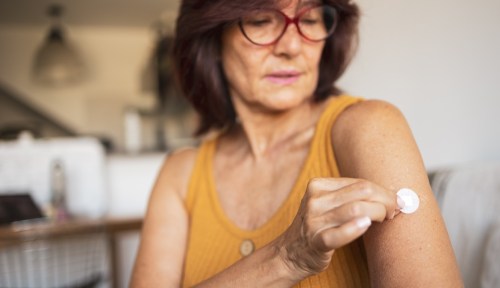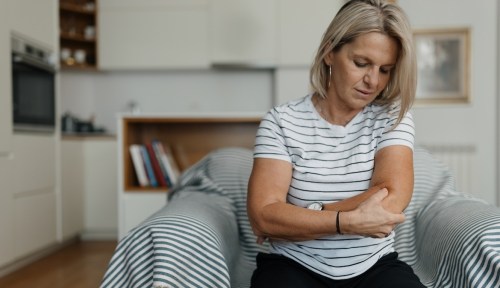These 4 Kinds of Exercise Can Help You Take Back Control of Your Body During Menopause
The decline of hormones in your 40s and 50s affects your entire body, but doing certain exercises during menopause can help manage symptoms.

When people talk about menopause—if people talk about menopause—the conversation tends to largely center around the in-the-moment symptoms, like hot flashes and night sweats. Less often, but increasingly more so (thankfully), it’s about the mental health effects, like brain fog, anxiety, and depression. All of which are associated with the end of menstruation and the natural decline in levels of estrogen, progesterone, and testosterone that happens to women during their 40s and 50s.
Experts in This Article
certified yoga and Pilates instructor and chief training officer at Pvolve
Jackie Giannelli, NP, is a founding nurse practitioner at Elektra Health.
What doesn’t get discussed nearly enough, though is how these hormonal shifts have long-term effects on brain, heart, and sexual health—or how certain exercises during menopause can help us address them.
“Women going through menopause feel like they’ve kind of lost control of their bodies—things are happening to them, and not necessarily by them,” says Jackie Giannelli, founding nurse practitioner at Elektra Health. “Fitness and exercise, for various reasons, are a way for women to take control of the menopausal experience and how they want to feel during it.”
Fortunately, Giannelli and Antonietta Vicario, lead trainer at P.volve, teamed up to create Moving With Menopause a newly launched fitness-and-education program that addresses the four areas of exercise they say women can benefit most from focusing on during this time. Their workout protocol is science-backed and evidenced-based, but may be counterintuitive to the way you train today. “Unfortunately, a lot of what we know about exercise is based on overweight, sedentary men, so women have to unlearn a lot of what they learned about fitness growing up,” Giannelli says.
“A lot of what we know about exercise is based on overweight, sedentary men, so women have to unlearn a lot of what they learned about fitness growing up.” —Nurse practitioner Jackie Giannelli
For example, both Giannelli and Vicario suggest workouts be shorter to prevent over stressing your body and elevating cortisol levels—which is already higher during menopause. It’s also more realistic to fit on a to-do list, which makes consistency, a key, more obtainable. “When you think of someone who’s in their 50s, they may be managing a career and family life, and 20 to 25 minutes is more doable—for everybody, really,” says Vicario. “You can get just what you need, if not more, from these shorter sessions, and hopefully that creates less friction for people.”
Aside from duration, it’s also about divvying up your allotted time to work out between the following buckets.
The 4 types of exercise to prioritize during menopause
1. Heavy weight lifting
“We’re losing estrogen when we’re going through menopause,” Giannelli says. “Estrogen is the impetus for building lean muscle mass, so you need to be strength training to maintain muscle.” Without extra strength workouts, women start losing one to two percent muscle mass year over year once menopause begins, Vicario says.
Muscle is metabolically active, so the more lean muscle mass you have, the better your resting metabolic rate will be. More importantly, lifting heavy weights triggers a hormonal response that burns visceral fat around your midsection, which tends to increase during menopause, according to Giannelli. “There’s a change during menopause in both body composition [ratio of body fat to lean muscle] and body shape,” she says, “so going from more of a pear shape to an apple shape. That accumulation of visceral fat can lead to adverse long-term health outcomes like diabetes, insulin resistance, inflammation, and cardiovascular disease.”
Building strength will also help address bone loss that can happen to women as they age. Vicario recommends strength training two to three times per week and focusing on low reps of heavy weights. “You’re not going for endurance, you’re going for maximum load, so like eight or 10 reps, maintaining form, but taking yourself to that muscle failure where your muscles are breaking down and then rebuilding,” she says.
The other thing that heavy weightlifting addresses is menopause joint pain and joint sensitivity, which can be triggered by the loss of estrogen, Vicario says. “Estrogen is very hydrating for the body,” she explains. “It’s really important in terms of keeping our connective tissue pliable, stretchy, and supportive, and so we really want to create muscular support around the joints, so that we’re taking care of them long-term.” Focus on exercises that move you through all different planes and ranges of motion. “Not just moving forward and back, but reaching down, up, rotating, in all directions,” Vicario says.
2. High intensity interval training
Heart disease is still the number one cause of death for women, Vicario says, and as such, aerobic exercise during menopause is very important. But she says those minutes shouldn’t be focused on building endurance through steady-state cardio, but rather on spiking your heart rate through high-intensity interval training (HIIT), maintaining your max effort for no more than 20 to 30 seconds at a time. “Then you back off for a bit,” Vicario says. “You want to go pedal to the metal, and then you take it down to a two or three [rate of perceived effort]. Steady-state cardio that’s like a six or a seven over a long period of time can be very counterproductive. I’m actually post-menopause, and this science was fascinating for me—20 to 25 minutes max of this 20 seconds on, and then two or three minutes to recover, and then hit it again, can be very transformative.”
HIIT allows you to reap the health benefits of cardio without spiking your cortisol levels the way long-duration endurance exercise does. “When we have high levels of stress in our body, it’s actually counterproductive to the functioning of our heart,” Vicario says. “When our bodies are in a stressed state, everything slows down—metabolism, our body’s ability to absorb the nutrients it needs from food—we go into this homeostasis hold, and we’re just not processing things as well.”
HIIT often tends to incorporate jump training or plyometrics, which is putting high impact on your bones, something that can help them get stronger and stay that way. “Our bones need impact and stimulation in order to stay strong, as well as weight-bearing exercise,” Vicario says. “So cardio is really good for maintaining bone density, which is important, because after the age of 50, 50 percent of women break a bone, and osteopenia and osteoporosis are real issues later in life.”
Cardio also increases blood flow to your brain, flooding it with oxygen and helping support its optimal function. “These short bursts of cardio fight brain fog and memory loss,” Vicario says.
3. Pelvic floor training
In addition to supporting your reproductive organs and bladder, and playing a significant role in your sexual health, your pelvic floor is the base of your core. Because estrogen is so lubricating, and a large number of estrogen hormone receptors live in this area of the body, women are more susceptible to pelvic floor dysfunction during menopause, Vicario says. “So incontinence, constipation, pelvic pain, which can be associated with intercourse penetration, are all common,” she adds.
As a reflex against these side effects, women sometimes overly train their pelvic floors to contract by gripping or bearing down too much, when they really need to be able to do both that and relax. “Also, people tend to hold tension in the hips and in their glutes,” Vicario adds.
Pelvic floor training is all about learning first how to properly contract and relax your pelvic floor (aka do a kegel) and then when to do each during certain exercises that require support from your core, like lifting a heavy weight, for example. “It can also be when you’re adding load, when you’re stabilizing, adding impact, or when you’re balancing on one leg,” Vicario adds. “These are places where engaging through the pelvic floor can be beneficial.”
4. Breathing exercises
The benefits of breathing exercises are two-fold when it comes to menopause—it can help you better connect to your pelvic floor, and it can also help keep you calm and regulate your nervous system, which in turn can help to reduce stress and the negative side effects it creates throughout your entire system.
“Breathing techniques can help you move from that high-cortisol, fight-or-flight state into your parasympathetic nervous system, so your rest-and-digest phase, which can help with things like insomnia and sleeplessness, even night sweats,” Vicario says. “It’s not that breathing is going to stop a night sweat, or stop you from waking up, but it’s more strategies and tools people can use to lower their stress.”
Oh hi! You look like someone who loves free workouts, discounts for cutting-edge wellness brands, and exclusive Well+Good content. Sign up for Well+, our online community of wellness insiders, and unlock your rewards instantly.
Sign Up for Our Daily Newsletter
Get all the latest in wellness, trends, food, fitness, beauty, and more delivered right to your inbox.
Got it, you've been added to our email list.










